Fシータ(FΘ)走査レンズ

- Scan Lenses for Laser Marking, Engraving, and Cutting Systems
- 1064 nm Design Wavelength
- Focal Length: 100 mm, 160 mm, or 254 mm
- Galvo Mounting Bracket Available
FTH100-1064
FTH160-1064-M39
M85 x 1.0 Thread
M39 x 1.0 Thread
FTH254-1064 Lens and
GVS012 Galvo Mirror
Pair in a GAS012
Mounting Bracket
FTHW42-1064
Replacement Protective
Window
FTHA1
60 mm Cage System or
SM3 Lens Tube Adapter

Please Wait
| Objective Lens Selection Guide |
|---|
| Objectives |
| Super Apochromatic Microscope Objectives Microscopy Objectives, Dry Microscopy Objectives, Oil Immersion Physiology Objectives, Water Dipping or Immersion Phase Contrast Objectives Long Working Distance Objectives Reflective Microscopy Objectives UV Focusing Objectives VIS and NIR Focusing Objectives |
| Scan Lenses and Tube Lenses |
| Scan Lenses F-Theta Scan Lenses Infinity-Corrected Tube Lenses |
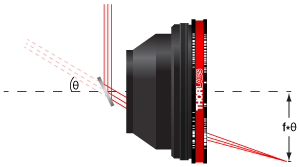
Click to Enlarge
Fシータ(FΘ)レンズでは出射ビームの変位は焦点距離fと走査角度θの積に比例します。 詳細については「Fシータ(FΘ)チュートリアル」タブをご参照ください。
| 下の型番横の赤いアイコン(資料)をクリックすると、各製品のZemaxファイルをダウンロードいただけます。 また、こちらからは当社の全てのZemaxファイルの一括ダウンロードが可能です。 |
特長
- Nd:YAGレーザーシステム用1064 nmの設計波長
- 平坦な像面
- 70 mm x 70 mm~156.7 mm x 156.7 mmの大きな走査範囲
- Fシータ(FΘ)湾曲収差:<0.1%または<1.3%
- M85 x 1.0またはM39 x 1.0ネジ加工でご用意
- エアスペース型設計
- 全ての光学素子はARコーティング付き
- 下記のアクセサリをご用意
- 交換用保護ガラス
- ガルバノミラー取付けブラケット
- 60 mmケージシステム、Ø50 mm~Ø50.8 mm(Ø2インチ)用レンズチューブ、Ø75 mm~Ø76.2 mm(Ø3インチ)用レンズチューブ用取付けアダプタ
当社のFシータ(FΘ)レンズはエアスペース型の2枚または3枚の素子の設計で次の3種類の焦点距離からお選びいただけます:100 mm、160 mm、または254 mm。 素子には1064 nm Nd:YAGレーザならびにアライメント用の可視レーザ向けに高効率なARコーティングが施されています(詳細については「グラフ」タ ブをご覧ください)。 各レンズの筐体の外側には標準的なM85 x 1.0またはM39 x 1.0のネジ切り加工がされているので、ScanLAB社、TRUMPF社、Datalogic社を含むほとんどのレーザーマーキングシステムに対応します。また、保護ガラスが1枚ついており、下記にご案内している方法で簡単に交換も可能です。 交換用のARコーティング付き保護ガラスもご用意しております。
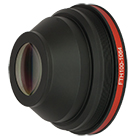
Click to Enlarge
FTH100-1064の背面
Fシータ(FΘ)レンズはガルバノ走査型レーザーマーキング、刻印、ならび に切断加工システムに使用するための標準的なレンズです。 回折限界性能を有し、複数の素子で構成されたエアスペース型の設計は、平坦な像面と低いFシータ(FΘ)湾曲収差を得られるように最適化されています。 Fシータレンズでは出射ビームの像面での変位はf*θと等しくなっております。ここでθは入射ビームの入射角です(上の図をご覧ください)。 従って、入射ビームと出射ビームの角速度は正比例するので、走査ミラーは一定の角速度で走査することができ、制御装置の大幅な簡素化につながっています。 Fシータレンズの詳細については「Fシータ(FΘ)チュートリアル」タブをご覧ください。
取付けオプション
このFシータ(FΘ)レンズは、大径ビーム用走査型ガルバノミラーシステムに取付け可能です。また下記にある取付けブラケットGAS012を使用いただくと、Fシータレンズをガルバノミラーから適切な距離をおいて取り付けることができます。 またFTH100-1064、FTH160-1064、FTH254-1064を60 mmケージシステムまたはSM3レンズチューブに取り付けるアダプタもご用意しております。FシータレンズFTH160-1064-M39は、SM2外ネジ-M39内ネジ変換アダプタSM2A29を使用してSM2レンズチューブに適合させることも可能です。
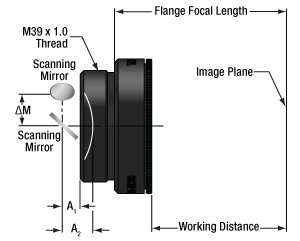
Click to Enlarge
FTH160-1064-M39 Schematic
プロット図の網掛けの部分はコーティングの波長範囲である450 nm~700 nm(Ravg<1.0%)および1020 nm~1080 nm(Ravg <0.3%)を示しています。この範囲外での性能は保証されていません。 可視域のARコーティングの範囲は、アライメント用のレーザの使用を想定したものです。 他のレンズ仕様についても可視波長域における性能のために最適化されていません。
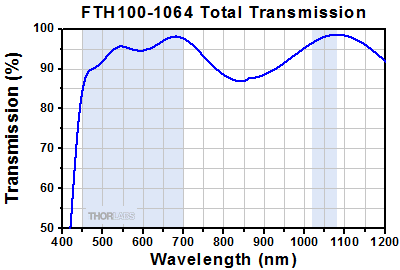
Click to Enlarge
生データはこちらからダウンロードいただけます。
Fシータ(FΘ)レンズFTH100-1064、FTH160-1064ならびにFTH254-1064は保護ウィンドウを含まずに3枚の光学素子の構造です。FTH160-1064ならびにFTH254-1064の透過率は上の図に類似していますが、光学素子の厚さによる相違があります。
Fシータ(FΘ)レンズ
Fシータ(FΘ)レンズは、レーザ走査や刻印システムが高い性能を発揮できるように設計されています。 このレンズは、レーザによる刻印やラベリングシステム、ならびにレーザ転写やレーザ加工に適しています。 レーザ走査や刻印の多くの用途において、最良の結果を得るためには平坦な像面が求められます。 球面レンズは円形面に沿ってのみしか結像ができません(図1A参照)。 この問題は平坦な像面を走査するレンズ系によって解消することができます。 しかし、ビームの変位は有効焦点距離(f)と偏向角θの正接[f × tan (θ)、図1 B参照]によって決まります。
この場合、変位と偏向角の非線形な関係は適切なソフトウェアのアルゴリズムで補正できますが、最も有効な解決策は線形な変位(つまり、一定の走査速度)を実現することです。 Fシータ(FΘ)レンズは、たる型の湾曲収差を得られるよう設計されているのでビーム変位はθに対して線形となります(f*θ、図1 C参照)。 このシンプルな関係により複雑な電子装置による補正が不要となり、速くて比較的費用がかからないコンパクトな走査システムが可能になるのです。
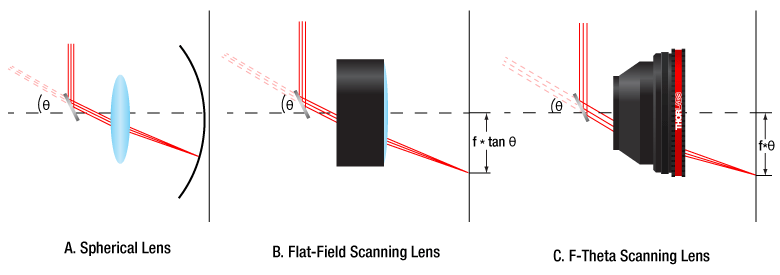
Click to Enlarge
図1:走査レンズ
Fシータ(FΘ)レンズは、レーザ走査にまつわる多くの問題を解決します。 またFシータ(FΘ)レンズのコンパクトな設計により、平坦な像面を作るために必要な光学部品の数を減らすことができます。 このレンズによってより小さいスポットサイズが得られるので、走査や印刷においては高解像度、刻印や溶接では高強度につながります。 さらに重要なことは、解像度や強度を決めるスポットサイズが像面全体に渡ってほぼ一定であることです。
走査レンズのセットアップ
レーザ走査システムは、レーザービームのウェストサイズ(集光されたスポット径)およびビームウェストの正確な位置決めについて精密な制御ができるよう最適化されています。 通常レーザ走査システムには、機能によって1枚ないし2枚の走査ミラーが組み込まれます。 例えば走査ミラーが1枚のシステムでは、ミラーはFシータ(FΘ)レンズの入射瞳の位置に置かれます。 ミラーが2枚のシステムの場合では、Fシータ(FΘ)レンズの入射瞳が2枚のミラーの間の位置に置かれます。 Fシータ(FΘ)レンズの性能を最大限に引き出すには、ミラー間の距離を最小限に抑える必要があります。
走査レンズ特性
Fシータ(FΘ)レンズを選択するにあたり、考慮すべき重要な要素として動作波長、スポットサイズ、そして走査範囲直径(SFD)があります。 これらのパラメータをふまえて、走査システムの入射ビーム径、走査ミラーの偏向、ミラーの配置や位置などに更なる制約が加わります。
走査範囲直径(SFD)、または走査長は、レンズによってビームが集光される正方形の像面の対角線の長さです。 どれくらいのSFDが欲しいかにより、偏向(ならびに焦点距離)が決められます。 出射ビームの走査角度(OSA)は、走査レンズを透過後の出射ビームと像面の垂線の間の角度です。 OSAは像面のいたる場所で変わりますが、この違いは、走査や刻印といったプロセスの性能に大きく影響するものではありません。 またテレセントリックレンズの場合、OSAは常にゼロとなります。 背面焦点距離(BFL)は、実際のレンズ(外側の素子)の頂部から近軸の焦点までの距離です。 背面作動距離(BWD)は、単にレンズの筐体の端から近軸の焦点までの距離です。
もう1つ考慮すべき重要なパラメータは、像面の歪みと湾曲です。 Fシータ(FΘ)レンズは平坦な像面を得られるように設計されていますが、実際のレンズは理論上の基準を満たすことはほとんどありません。 若干の歪みと湾曲は存在します。 図2ではFシータ(FΘ)レンズFTH100-1064のパラメータを示しています。ここで、焦点距離は100 mm、最大偏向角は28°です。 走査角度に応じた像面湾曲をミリ単位で、Fシータ(FΘ)湾曲収差を%で表しています。 走査システムを構築する際には通常、湾曲がゼロになる地点をスキャン範囲の中間に置くと、走査中の湾曲の発生を小さくすることができます。
まとめ
先に述べたとおり、レーザーシステムでは必要な解像度を得るために適切なスポットサイズを得ることと、平坦な像面のどの場所でもスポットを正確に位置決めすることが達成すべき目標となります。 回折限界性能を有する走査レンズのスポットサイズは、一般的に以下の式で算出します。

スポットサイズは1/e2ビーム径、λはレーザの波長、fはレンズの有効焦点距離、Aは入射瞳径です。 Cは、瞳の照度ならびに入射ビームの裾切りに関連する定数です(ガウシアンビームでは、入射ビームが1/e2径で裾切り時 C = 1.83となります)。
また焦点距離は、以下の通り、走査範囲の直径にも影響を及ぼします。

Lは正方形の走査範囲の対角線長、θはラジアンで表した最大偏向角度、そしてfはレンズの有効焦点距離(EFL)です。 システムでθを最大にすれば焦点距離を最少に抑えることができます。 これは光学素子のサイズを抑え、コンパクトでコスト効率の良いシステムをつくる上で、Lを維持するための方法として一般的に推奨されています。 さらに、走査ミラーのモータの不安定な動きによって生じるFシータ(FΘ)湾曲収差は、EFLを短くすることによって小さくすることができます。
| Posted Comments: | |
christiaan van den Berg
(posted 2022-11-25 14:00:25.87) The lens is designed for 1064nm wavelength.
I am considering to use it for 532nm wavelength. Do you have performance data of this lens for this wavelength? cdolbashian
(posted 2022-11-28 12:42:18.0) Thank you for your inquiry Christiaan. While we do not have this type of data presented, using the Zemax blackbox file on our website, you can change operational parameters to simulate the performance at 532nm for any of our components. I have contacted you directly to discuss this. user
(posted 2021-08-11 11:16:43.17) Can't find the F-Theta lens D.O.F like FTH160-1064 FTH100-1064 FTH254-1064; Please show me cdolbashian
(posted 2021-09-29 10:13:27.0) Thank you for reaching out to us here at Thorlabs. We have calculated approximate D.O.F for each of the requested lenses.
All were calculated using 1064nm as wavelength
FTH100-1064 :190um with incoming beam diameter of 12mm
FTH160-1064-M39: 1.1mm with incoming beam diameter of 8mm
FTH160-1064 : 500um with incoming beam diameter of 12mm
FTH254-1064 : 450um with incoming beam diameter of 20mm
I do not have your contact information to discuss this further, but hopefully this helps. Feel free to contact us directly via Techsupport@thorlabs.com with further inquiries. David Willis
(posted 2021-03-17 09:56:10.51) Do you have f-theta lenses for 3rd harmonic Nd lasers? I see galvo scanners for the 3rd harmonic (355 nm), but no corresponding f-theta lenses. I am specifically interested in 349 nm for a Nd:YLF. YLohia
(posted 2021-03-18 02:37:15.0) Hello, thank you for contacting Thorlabs. Unfortunately, we don't offer such an f-theta lens at the moment. ning xu
(posted 2020-09-26 14:43:16.027) 请问是否有f-θ透镜的光路图,或者光路实物图,最好在显微成像系统中。光路有点相像不明白,不知道该怎么安装,调节。谢谢!
https://www.thorlabschina.cn/newgrouppage9.cfm?objectgroup_id=6430 YLohia
(posted 2020-09-28 08:35:24.0) Hello, thank you for contacting Thorlabs. An applications engineer from our team in China (techsupport-cn@thorlabs.com) will reach out to you directly to discuss this. user
(posted 2020-07-27 14:41:04.697) I would like to know about OSA of f theta lens FTH160-1064. Would you please show me the graph of OSA about FTH160-1064?
x axis: sgittal/tangential distance(mm)
y axis: OSA(radian or degree) nbayconich
(posted 2020-07-29 08:28:36.0) Thank you for contacting Thorlabs, the OSA or Output Scan Angle is the angle between the output laser beam after it has passed through the scan lens and the normal of the image plane. The field position of the focused source can be determined by the equation F*Θ where Θ is the OSA after the f-theta lens.
Please see our OSA tutorial below.
https://www.thorlabs.co.jp/newgrouppage9.cfm?objectgroup_id=6430&tabname=f-theta%20tutorial jysohn
(posted 2018-02-05 23:56:44.083) Hi,
My name is Jin Sohn, optical engineer in SD Optics, Inc.
I would like to know about the optical design of the your f-theta lenses, especially, FTH100-1064
Is it designed only for 1064nm or broadband applications?
if possible, can I have optical design files with code v format or zemax format?
Thanks,
Jin. tfrisch
(posted 2018-02-06 09:28:09.0) Hello, Thank you for contacting Thorlabs. The F-Theta lenses are designed for laser applications, though the AR coating has <0.3% average reflectance per surface over 1020 nm - 1080nm. It will also allow a visible guide beam, but the design of the lens is not optimized for any visible wavelengths. While we offer Zemax files in the Docs icon below, this is a black box, and the full prescription is considered proprietary. I will reach out to you directly about your application solowing367
(posted 2017-07-20 11:37:09.393) Hope all is well. I am considering using a F-theta lens for a 532nm pulse laser. How would these lenses perform? tfrisch
(posted 2017-07-26 03:15:47.0) Hello, thank you for contacting Thorlabs. I would expect the damage threshold to be lower at 532nm than at 1064nm. I will reach out to you directly to discuss the other performance specs you are looking for. h.wu
(posted 2017-05-28 23:56:07.587) Hello, could you tell me which tube lens can be used to pair with your F-Theta scan lens?
I would like to pair a F-Theta scan lens with a tube lens to build a light sheet microscope since the beam displacement of F-theta lenses is linear with θ. Thank you. tfrisch
(posted 2017-06-22 08:49:22.0) Hello, thank you for contacting Thorlabs. F-Theta Scan lenses provide a flat imaging plane on their own without additional elements. I will reach out to you directly about the needs of your application such as field of view. mskang
(posted 2016-12-22 10:27:27.457) Dear sir,
FTH series is for only 1064nm wavelength in optimization performance as spec.
If I use this item around 532nm visivle wavelength, is the performance of this series bad? tfrisch
(posted 2016-12-28 04:44:55.0) Hello, thank you for contacting Thorlabs. The visible transmission is given because visible alignment beams are common. These F-Theta lenses are designed for use at 1064nm. I will contact you directly about the performance for visible wavelengths. york.tsai
(posted 2016-09-07 12:38:34.01) I wanna to ask some question about F-theta lens.
1. Why EFL is smaller than Working distance.
2. I can calculate the spot position by scan angle and EFL? ex. Y=f*theta tfrisch
(posted 2016-09-08 09:03:14.0) Hello, thank you for contacting Thorlabs. The Working distance is a mechanical spec measured with respect to the housing, while the EFL is an optical spec measured from the principal plane. In this case, the principal plane falls outside the housing. Yes, the beam position will be f*theta as shown in our F-Theta Tutorial tab. hyubkorea
(posted 2016-05-18 08:35:02.077) I am looking for F theta lens covering broad band wavelength range, but I couldn't find proper products. Is there any product working in broad wavelength range which covers from UV to IR? The products are for manufacturing application, so I think aberration and high reflectivity aren't important, and damage threshold is the only issue I concern. If there isn't existing product, is it possible to make customized product? besembeson
(posted 2016-05-19 10:27:38.0) Response from Bweh at Thorlabs USA: We will contact you to further discuss your requirements for a customized solution. vkancharla
(posted 2014-09-04 14:14:19.93) Do you have any data on total transmission of FTH100-1064 at 1030nm? Thank you, VK besembeson
(posted 2014-09-10 03:36:52.0) Response from Bweh: We show the total spectral transmission for the FTH100-1064 at the following link under the "Graphs" tab: http://www.thorlabs.com/newgrouppage9.cfm?objectgroup_id=6430&pn=FTH100-1064#7314.
This should include 1030nm. We also have the excel data below the plot. wutong
(posted 2013-12-27 16:32:43.53) Hello! I cannot open the FTH160-1064 zemax file using my zemax program for its version is zemax-2009-32bit. Could you send me a zmx copy for my edition? Thank you! tcohen
(posted 2014-01-02 04:00:00.0) Response from Tim at Thorlabs: Thanks for contacting us. We're in the process of uploading .zmx files for older Zemax versions to compliment the newer .zar files we currently have available in the product documents. In the meantime, our support engineers (techsupport@thorlabs.com) can convert them. I've sent the file via email for your review. moskalev
(posted 2013-10-11 13:06:00.917) Hello,
Do you have any data on total transmission of FTH254-1064 at 2100nm? What would be lead time for FTH254-1064 lens with custom AR coating for 2100nm and visible (for guide laser beam)?
Thank you,
Igor pbui
(posted 2013-10-28 14:51:00.0) Response from Phong at Thorlabs: The transmission for FTH254 at 2.1 um is about 59%. We will contact you directly to discuss the possibility of offering a custom coated lens. power357753
(posted 2013-05-05 08:57:45.62) i can not open FTH100-1064 zemax file ,i want to open it by zemax2005 .could you send me a copy? jlow
(posted 2013-05-09 16:29:00.0) Response from Jeremy at Thorlabs: It seems that the current Zemax file on the website is not compatible with your version. I will get in contact with you for a copy for your edition. |


- Fシータ(FΘ)走査レンズ用保護ガラス、交換用
- Ø42 mm、Ø75 mm、またはØ110 mmをご用意
- 取付け簡単
上記Fシータ(FΘ)走査レンズの交換用保護ガラスをご提供しております。保護ガラスには1064 nm(Fシータ(FΘ)レンズの設計波長)と450~700 nmの波長範囲(アライメントの目的で使用される可視レーザ)用に最適化されたARコーティングが施されています。
交換するには、Fシータ(FΘ)レンズの大開口部の前に付いている固定リングを回して外してください。古い保護ガラスを外した後、固定リングのネジ加工部分を上にして持ってください(左下の写真をご参照ください)。 新しい保護ガラスをリングの中央にある陥凹部に置きます。Fシータ(FΘ)レンズの大開口部が下を向くように筐体を持ち、固定リングを回して筐体に取付けてください。
| Item # | FTHW75-1064 | FTHW42-1064 | FTHW110-1064 |
|---|---|---|---|
| Compatible Lenses | FTH100-1064, FTH160-1064 | FTH160-1064-M39 | FTH254-1064 |
| Diameter | 75 mm (2.95") | 42 mm (1.65") | 110 mm (4.33") |
| Diameter Tolerance | +0 mm/-0.1 mm | +0 mm/-0.15 mm | +0.5 mm/-1.0 mm |
| Thickness | 2.0 mm (0.08") | 1.6 mm (0.06") | 3.0 mm (0.12") |
| Thickness Tolerance | ±0.1 mm | ||
| Parallelism | ≤3 arcmin | ≤2 arcmin | ≤3 arcmin |
| Clear Aperture | Ø71 mm | Ø40 mm | Ø104 mm |
| Substrate | N-BK7 | ||
| Surface Quality | 20-10 Scratch-Dig | ||
| Transmitted Wavefront Error (Peak to Valley) | <1λ @ 633 nm | <1λ @ 633 nm | <1.5λ @ 633 nm |
| AR Coatinga | 1020 nm - 1080 nm: Ravg <0.3% 450 nm - 700 nm: Ravg < 1.0% | ||
| Damage Threshold | 20 J/cm2 (1064 nm, Ø1 mm, 10 ns, 10 Hz) | ||

- Fシータ(FΘ)走査レンズと大径ビーム用ガルバノミラーシステムを取付けるブラケット
- 取り外し可能な光入力プレートは30 mmケージシステムならびにSM1ネジシリーズ製品に対応
- Fシータ(FΘ)レンズを取付けるためにはネジアダプタが別途必要(下記掲載)
- インチ、ミリ規格両方のブレッドボードならびに光学テーブルに取付け可能
GAS012は、M85ネジまたはM39ネジ加工のFシータ(FΘ)走査レンズと2軸大径ガルバノメーターミラーシステムを組み合わせるための取付けブラケットです。 出来上がったアセンブリは、光学システムを構築する光学テーブルやブレッドボードに組み込むことも可能です。 取付けブラケットGAS012を使用するには別途ネジアダプタのご購入が必要です(下記掲載)。 このネジアダプタによってレンズを2枚目のガルバノミラーから推奨距離、A1の位置に配置することができます(「概要」タブの図をご覧ください)。 Fシータ(FΘ)レンズに取付け可能なネジアダプタについては下の表をご覧ください。
光入力ポートにあるSM1(1.035"-40)ネジ切り加工によってØ25 mm~Ø25.4 mm(Ø1インチ)レンズチューブに取付けられます。また、Ø6 mmのケージロッド用の穴が4つ付いているので30 mmケージシステムに組み込むこともできます。 GAS012は底面にある12.6 mm間隔の8つのM4貫通穴、および25.2 mm間隔の9つのM6貫通穴により、ミリ規格ならびにインチ規格両方のブレッドボードや光学テーブルに取り付けることができます。 取付け時、ガルバノミラーシステムGVS012/Mは直接(底面の)取付け面にのせないため、すべての貫通穴を光学テーブルまたはブレッドボードの取付けに使用することができます。
| Mounting Bracket Item # | GAS012 | ||
|---|---|---|---|
| Thread Adapter Item # | GAS0121 | GAS0122 | GAS0124 |
| Compatible Scan Lens | FTH100-1064 FTH160-1064 | FTH254-1064 | FTH160-1064-M39 |
| Compatible Galvo Mirror System | Large Beam Diameter Dual-Axis Galvo Systems | ||
| Assembled System Photo (Click for Details) | 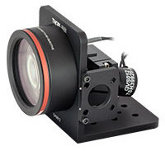 | 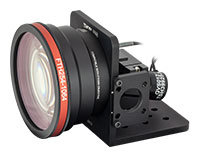 | 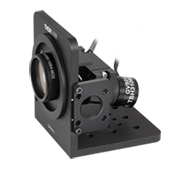 |

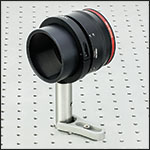
Click to Enlarge
Fシータ(FΘ)レンズFTH100-1064をØ75 mm~Ø76.2 mm(Ø3インチ)レンズチューブに取り付け。アダプタFTHA1、ポスト取り付け用アダプタSM3TC、台座付きピラーポストを使用。
- Fシータ(FΘ)レンズFTH100-1064、FTH160-1064、FTH254-1064をØ75 mm~Ø76.2 mm(Ø3インチ)レンズチューブまたは 60 mmケージシステムに組み込み可能
- Fシータ(FΘ)レンズFTH160-1064-M39をØ50 mm~Ø50.8 mm(Ø2インチ)レンズチューブに組み込み可能
こちらの取付けアダプタにより、当社のFシータ(FΘ)走査レンズをレンズチューブシステムに取り付けることができます。アダプタSM2A29にはSM2外ネジが付いていて、当社のSM2レンズチューブ付きFシータ(FΘ)レンズFTH160-1064-M39に取り付けられます。アダプタFTHA1ならびにFTHA2にはØ6 mmケージロッド用の取り付け穴が4つあり、60 mmケージシステムに組み込みが可能です。またSM3内ネジによりØ75 mm~Ø76.2 mm(Ø3インチ)レンズチューブにも取り付けができます。部品同士がぶつかるため、60 mmケージシステムとØ75 mm~Ø76.2 mm(Ø3インチ)レンズチューブは同時に使用することはできません。互換性については下の表をご参照ください。
| Adapter Item # | FTHA1 | FTHA2 | SM2A29 |
|---|---|---|---|
| Compatible Scan Lens | FTH100-1064 FTH160-1064 | FTH254-1064 | FTH160-1064-M39 |
| Mounting Compatibility | 60 mm Cage Systems Ø3" Lens Tubes | Ø2" Lens Tubes | |
注: M85 x 1.0ネジのFシータ(FΘ)のレンズは大きいため、ケージシステムまたはレンズチューブで支え、支柱とレンズの間距離をできるだけ短くすることをお勧めします。例として右の写真をご覧ください。
アセンブリ図

Click to Enlarge
アダプタFTHA1に取り付けたFシータ(FΘ)レンズFTH100-1064
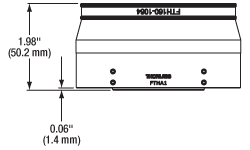
Click to Enlarge
アダプタFTHA1に取り付けたFシータ(FΘ)レンズFTH160-1064
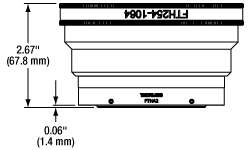
Click to Enlarge
アダプタFTHA2に取り付けたFシータ(FΘ)レンズFTH254-1064
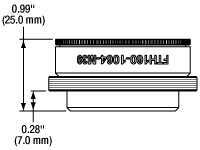
Click to Enlarge
アダプタSM2A29に取り付けたFシータ(FΘ)レンズFTH160-1064-M39
 Products Home
Products Home








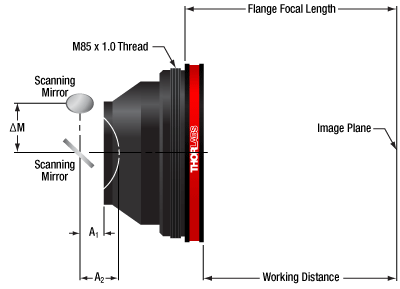
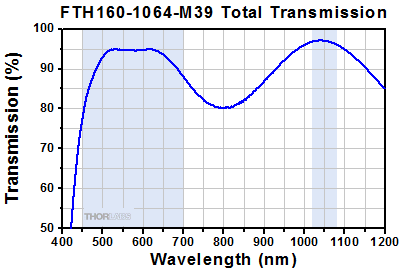
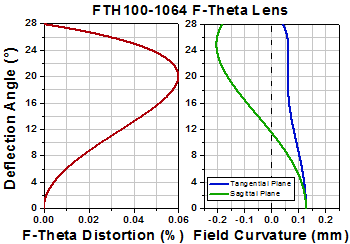
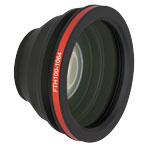
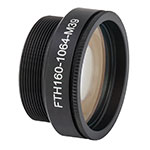
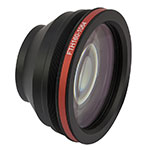
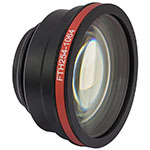
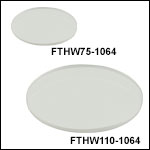
 ズーム
ズーム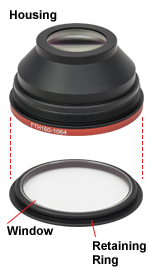
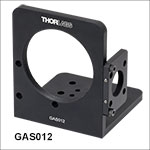
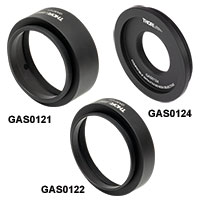
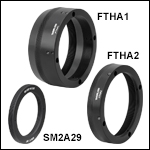
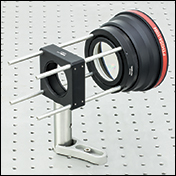
 Fシータ(FΘ)走査レンズ
Fシータ(FΘ)走査レンズ